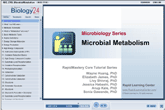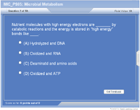| How to Learn in 24 Hours? |
|
| Need Help? |
M-F: 9am-5pm(PST):
Toll-Free: (877) RAPID-10
or 1-877-727-4310
24/7 Online Technical Support:
The Rapid Support Center
vip@rapidlearningcenter.com
Secure Online Order:

|
| Tell-A-Friend: |
Have friends taking science and math courses too? Tell them about our rapid learning system.
|
|
Microbial Metabolism
| Topic Review on "Title": |
Metabolism
- Metabolism is the sum of all chemical reactions within an organism.
- The chemical processes in a living cell or organism.
- In metabolism some substances are broken down to yield energy while others are synthesized which requires energy.
- All metabolisms have some common features. These features include a requirement for the nutrient to get into the cell and that the nutrient be available to be metabolized.
- The complementary process of catabolism and anabolism create energy and building materials. This energy and building materials are used in biosynthesis, assemble, polymerization and general cell survival.
- The process of catabolism and anabolism may utilize different pathways depending on the cell, nutrient and current environmental pressures the cell is currently experiencing.
Energy Production
- Nutrient molecules have energy electrons associated with their chemical bonds.
- Catabolic processes oxidize the electrons (remove electrons) and store them in other accessible high energy bonds like ATP.
- ATP (adenosine triphosphate) is an energy form that is retrievable by the cell.
- ATP and ADP (adenosine diphosphate) have high energy phosphate bonds with a negative fee energy of around 7 Kcal per mole.
- Oxidation and reduction reactions are couples (redox).
- Oxidation is the removal of electrons from a molecule.
- Reduction is the acquisition of electrons.
- Oxidation reaction release energy. In the cell oxidation usually is accompanied by the loss of hydrogen atoms from a complex substrate molecule in the process electrons are usually lost as well. When a molecule is oxidized it gives up energy.
- Reduction reactions grab or trap chemical energy. The substrate or complex bimolecular gains electrons and or hydrogens. A molecule that has been reduced (e.g. accepted an electron) is energy rich.
- Substrate level phosphorylation is the transfer of phosphate to ADP from another phosphorylated organic compound.
- Oxidative phosphorylation is the process in which energy from redox reactions of respiration is used to attach an inorganic phosphate to ADP.
- Photophosphorylation is the process in which light energy is used to phosphorylate ADP with inorganic phosphate.
- Nicotinamide adenine dinucleotide (NAD+) and nicotinamide adenine dinucleotide phosphate (NADP+) are cofactors in cells and act as electron carriers. NAD+ is reduced to NADH and NADPH is reduced to NADP+.
- Flavin adenine dinucleotide FADH and FADH2 are reduced forms of FAD. FADH2 is produced in the citric acid cycle.
Metabolic Cycles
- Glycolysis: a single molecule of glucose yields two molecules of pyruvic acid (pyruvate). There are 4 ATPs formed and two used in the cycle. Therefore there is a net of 2 ATPs. Two molecules of NAD+ are reduced to NADH.
- Krebs Cycle: also known as TCA Cycle (tricarboxylic acid cycle). Pyruvic acid is decarboxylated to acetate. The acetate is attached to coenzyme A in the process a molecule of NAD+ is reduced to NADH. For every two molecules of acetyl-CoA in the Krebs cycle two molecules of ATP are generated. In redox reactions for every two molecules of acetyl-CoA entering Krebs cycle six molecules of NADH and two of FADH2 are made. The NADH and FADH2 are the most important products of the Krebs cycle.
- Electron Transport: The largest amounts of ATP produced are in the Electron Transport chain. This is a series of membrane bound carrier molecules that pass or transfer electrons from one to the next and ultimately to a final electron acceptor. The electrons’ energy is used to pump protons across the membrane. Electron transport chain in eukaryotes are in the inner mitochondrial membranes in prokaryotes it is in the cytoplasmic membrane. Electron carrier molecules are diverse and in prokaryotes can change depending on environmental factors. These carriers include: flavoproteins, ubiquinones, metal containing proteins and cytochomes. Electrons carried by NADH enter the chain at a flavoprotein, FADH2 are introduced by a ubiquinone. Final electron acceptors include oxygen atoms which can make H2O upon the addition of hydrogen ions. The later is aerobic respiration. In anaerobic respiration use other inorganic molecules (rarely organic molecules) instead of oxygen as the final electron acceptor. In aerobic electron transport chain 34 ATP are produced.
- Fermentation: the partial oxidation of metabolites releasing energy using an organic molecule as an electron acceptor instead of the electron transport chain. Fermentation oxidizes NADH to NAD+ while reducing organic molecules which are the final electron acceptors.
- Anabolic Processes: are reactions that synthesize or make something and require energy. The energy is provided by ATP. There are many anabolic pathways that are catabolic pathways running in revere. Example of anabolic process is the production of cell membrane and cell wall components such as cellulose and peptidoglycan.
|
| Rapid Study Kit for "Title": |
| Flash Movie |
Flash Game |
Flash Card |
| Core Concept Tutorial |
Problem Solving Drill |
Review Cheat Sheet |
 |
 |
 |
|
| "Title" Tutorial Summary : |
The living cell is either building molecules, which is referred to as anabolism or it is tearing molecules down called catabolism. The process of catabolism, that is the breakdown of molecules, is for energy generation or to create molecules used as building blocks for macromolecules. In catabolism molecules such as proteins, fats and carbohydrates are metabolized to yield energy storage molecules such as ATP, or precursor molecules for use in cell growth and homeostasis.
In anabolism the energy rich molecules are utilized along with precursor molecules to build macromolecules required by the cell for survival and replication. These macromolecules include DNA, enzymes and cell wall components. Catabolism and anabolism are processes that work in synchrony to optimize the cells ability to survive.
|
| Tutorial Features: |
Specific Tutorial Features:
- Step by step description of energy generating pathways.
- Detailed description of substrate level phosphorylation.
- Electron transport in cell membranes and mitochondria for ATP generation.
Series Features:
- Concept map showing inter-connections of new concepts in this tutorial.
- Definition slides introduce terms as they are needed.
- Visual representation of concepts.
- Step by step animated examples of catabolic processes.
- Practice quiz on major concepts of the tutorial.
|
| "Title" Topic List: |
Microbial metabolism may be summed up as a balance between catabolic and anabolic pathways.
Catabolic pathways generate energy by utilizing: carbohydrates, proteins and fats in metabolic cycles.
Anabolic pathways use the energy created in catabolic processes and precursor molecules to generate complex macromolecules. These molecules include: polysaccharides, lipids, amino acids, proteins and nucleotides.
Many pathways can be “forced” to run in reverse. Therefore pathways that are typically catabolic in reverse may function as an anabolic pathway.
|
See all 24 lessons in Anatomy and Physiology, including concept tutorials, problem drills and cheat sheets:
Teach Yourself Microbiology Visually in 24 Hours
|



